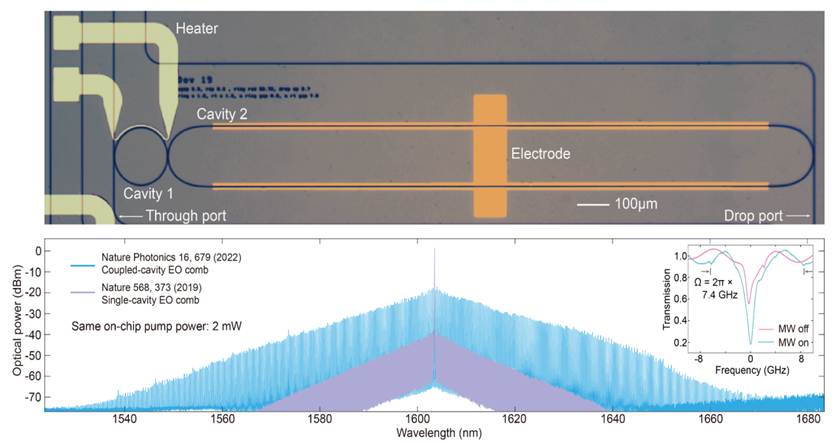
Nonlinear optics and frequency comb
Nonlinear Optics: Frequency Control and Light Generation
Nonlinear optics is a branch of physics that explores the manipulation and generation of light through nonlinear interactions in optical media. Unlike linear optics, where light-matter interactions are proportional to the incident field, nonlinear optics exploits higher-order polarization.
Frequency: One of Key Degrees of Freedom in Light Control
In optical systems, several degrees of freedom can be engineered to tailor light-matter interactions:
• Propagation direction (e.g., beam steering, phase matching)
• Polarization (e.g., birefringence, polarization rotation)
• Frequency: the most challenging yet crucial parameter, enabling multiple applications
Nonlinear optics provides a powerful toolkit for frequency control by leveraging the nonlinear components of the electric polarization in optical media. This allows for processes such as second-harmonic generation (SHG), sum/difference frequency generation (SFG/DFG), and optical parametric oscillation (OPO).
Historical Impact and Technological Contributions
Over the past decades, nonlinear optics has revolutionized both fundamental science and applied technologies. Before and after the rise of integrated photonics, second-order (χ⁽²⁾) and third-order (χ⁽³⁾) nonlinear effects are always serving as the backbone of modern optical innovations:
A. Second-Order Nonlinear Effects (χ⁽²⁾)
• Frequency up-conversion: Enables efficient detection of mid-infrared photons by converting them into visible/near-infrared wavelengths, critical for spectroscopy and thermal imaging.
• Pockels effect: Facilitates ultra-fast electro-optic modulation, forming the basis of high-speed fiber-optic communication and optical signal processing.
B. Third-Order Nonlinear Effects (χ⁽³⁾)
• Four-wave mixing (FWM): A cornerstone of quantum optics, enabling the generation of entangled photon pairs for quantum key distribution (QKD) and quantum computing.
• Kerr effect: Essential for all-optical switching, soliton formation, and ultra-short pulse characterization, underpinning advancements in ultra-fast lasers and nonlinear microscopy.
Flourish of Integrated Nonlinear Optics Platform
With the advent of integrated nonlinear photonics, engineered materials—such as metasurfaces and 2D materials—along with on-chip nonlinear devices are pushing the boundaries of efficiency and miniaturization. These platforms offer key advantages:
• Compactness, enabling broader application scenarios;
• Tight light field confinement, drastically reducing power consumption;
• CMOS compatibility, facilitating mass production and cost reduction.
These advancements are paving the way for transformative applications in quantum technologies, biomedical imaging, and next-generation optical computing.
An impressive exemplar is: integrated photonics has revolutionized Kerr frequency comb generation by enabling three key performance enhancements: (1) significantly reduced power thresholds, (2) improved conversion efficiency, and (3) broader spectral bandwidth - all critical parameters for practical comb generation systems¹.
While numerous material platforms have emerged to support these advancements, certain bulk nonlinear optical materials (e.g., Lithium Niobate) face persistent fabrication challenges that have hindered their successful integration into photonic circuits. These manufacturing limitations have caused traditionally strong bulk optical materials to fall behind in the transition to integrated platforms.
Emergence of Thin-Film Lithium Niobate Platform and Our Pioneering Contributions
Recent breakthroughs in fabrication technology have enabled the emergence of high-performance integrated electro-optic (EO) platforms. Materials like Lithium Niobate, long favored in free-space nonlinear optics, has demonstrated remarkable performance in its thin-film configurations (TFLN). This integrated platform combines the excellent nonlinear properties of bulk crystals with the advantages of chip-scale photonics².
TFLN has offered unprecedented programmability and performance in photonic circuits, first shown extraordinary χ⁽²⁾ properties.
• The Pockels effect in TFLN has demonstrated transformative potential for electro-optic conversion³.
• On-chip Periodic Poled Lithium Niobate (PPLN) structures have emerged as leading candidates for efficient frequency up/down conversion applications⁴.
Our research group has achieved several groundbreaking milestones in this field:
• Developed the General Critical Coupling (GCC) theory, a fundamental advancement in photonic coupling design. Demonstrated a 28 GHz optical frequency conversion with 90% conversion efficiency: a world-record performance⁵.
• Successfully applied GCC theory to electro-optic comb generation, with optimized coupled-ring resonator designs and precisely engineered coupling coefficients.Significant improvement in comb generation energy efficiency has been achieved: an 100-fold improvement⁶.
Beyond electro-optic applications, χ⁽³⁾ nonlinear effects in Thin-Film Lithium Niobate (TFLN) has been successfully engineered, achieving an octave-spanning Kerr comb with suppressed Raman gain effect⁷.
Current Research Focus
Our group is actively pursuing:
• Comprehensive exploration of nonlinear phenomena in these emerging photonic platforms
• Development of novel approaches that bridge fundamental physics with practical applications
• Optimization of nonlinear processes for next-generation photonic devices

Fig. 1 | On-chip electro-optic frequency shifters and beam splitters

Fig. 2 | High-efficiency and broadband on-chip electro-optic frequency comb

Fig. 3 | Octave-spanning Kerr soliton frequency combs in dispesion- and dissipation-engineered lithium niobate micro-resonators
[1] Herr, T. et al. Temporal solitons in optical microresonators. Nature Photon 8, 145–152 (2014).
[2] Zhu, D. et al. Integrated photonics on thin-film lithium niobate. Adv. Opt. Photon. 13, 242 (2021).
[3] Wang, C. et al. Integrated lithium niobate electro-optic modulators operating at CMOS-compatible voltages. Nature 562, 101–104 (2018).
[4] Wang, C. et al. Ultrahigh-efficiency wavelength conversion in nanophotonic periodically poled lithium niobate waveguides. Optica 5, 1438 (2018).
[5] Hu, Y. et al. On-chip electro-optic frequency shifters and beam splitters. Nature 599, 587–593 (2021).
[6] Hu, Y. et al. High-efficiency and broadband on-chip electro-optic frequency comb generators. Nat. Photon. 16, 679–685 (2022).
[7] Song, Y. et al.Octave-spanning Kerr soliton frequency combs in dispersion- and dissipation-engineered lithium niobate microresonators. Light Sci Appl 13, 225 (2024)

